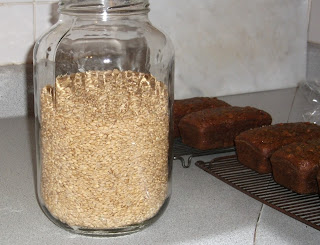Nerd Alert: If you are not fascinated by measuring cup adventures, you may just want to skip to the end for the flour tortilla recipe.
I used to take measuring cups for granted. I presumed that they all measured the same amounts. Last summer I found that this isn't necessarily so.
Our family rented a house on a lake. The second day there I made tortillas for chicken enchiladas. My recipe always worked great, whether I halved or doubled it; whether I used white or whole wheat flour. But on this day, when I was making enough for 16 people, the dough turned out very dry. I managed to renovate it, and the tortillas, though not my best, were still good. But I couldn't figure out what happened.
Later in the week I noticed a set of dry measuring cups different from the ones I had used for the tortillas. I noticed that the 1-cup I used to measure the flour for the tortillas appeared to be bigger than the other one. So I took a liquid measuring cup, measured 1 cup of water in it, and poured it into the first cup. There was unfilled space. Quite a bit of it. The water fit exactly into the second cup. I even poured the water back into the liquid measuring cup to make sure the amount was constant. It turned out that the first "cup" held about another 1/4 cup! With 5 cups of flour called for in the tortillas, that meant I had added about 1-1/4 cups too much! No wonder the dough was so dry!
 |
| Whole Wheat Tortillas |
At home I have a few different sets of measuring cups, so I thought I would compare 1-cup amounts.
The red (Betty Crocker) cup was labeled 1 C/235 ml, so I weighed it with 235 ml (grams) of water in it. The water filled it perfectly to the brim. I poured the water and weighed it in the orange and white dry measuring cups. The 235 grams remained constant and the water filled them perfectly to their brims as well. Next I poured the water into the Betty Crocker liquid measuring cup. The water came right up to the 1-cup line and weighed 235 grams. Then I poured the water into my Pyrex 2-cup measure. The 235 grams of water rose markedly above the 1-cup line. I had to take out 25 grams of water, or 5 teaspoons, for it to match the 1-cup line at 210 grams. Poured into my Pyrex 1-cup measure, 235 grams of water rose slightly above the 1-cup line. To match the 1-cup line, I had to take out 11 grams of water, or 2 teaspoons, and it weighed 224 grams. So Pyrex didn't come out looking so good.
Wikipedia: "The cup currently used in the United States for nutrition labeling is defined in United States law as 240 mL."
King Arthur Flour: "1 cup = 227 (or 230) ml/g." This discrepancy of standards, about 1 tablespoon difference, surprised me. At 235 ml/g, most of my measuring cups fall in the middle of this range and are consistent with each other. Interestingly, both Pyrex measuring cups not only fall below this range but are inconsistent with each other.
Flour Tortillas
5 C flour (originally called for white, but I use whole wheat)
2 1/2 tsp. salt
3 tsp. baking powder
1 1/2 C very hot water
5 Tbsp. canola oil (originally called for shortening; oil works really well)
Mix together dry ingredients. Pour oil into the hot water. Then pour the liquids into the dry ingredients. Stir together with a spoon, and then squish together with hands and knead slightly until you have a cohesive ball. You may need to add a bit more water or flour. Make about 20 golf ball-sized balls of dough. Cover them with a towel or wax paper so they don't dry out. Let rest for a few minutes. Using a little flour, roll each ball very thin. Cook in a dry skillet on high heat, turning as soon as it starts to bubble; cook for a few more seconds. Do not over-cook. Place cooked tortillas inside a folded tea towel.
Making 20 tortillas all at once can be tedious. So, if I just need a few, I decrease the recipe amounts as follows:
1/3 Recipe: (yields 6-7 tortillas)
1 2/3 C flour
3/4 tsp. salt
1 tsp. baking powder
1/2 C very hot water
1 2/3 Tbsp. canola oil
1/5 Recipe: (yields 4 tortillas)
1 C flour
1/2 tsp. salt
1/2 tsp. (generous) baking powder
1/3 C (scant) very hot water
1 Tbsp. canola oil





























